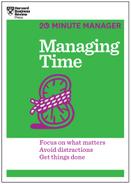Learn More
Recent research
Birkinshaw, Julian, and Jordan Cohan. “Make Time for the Work That Matters.” Harvard Business Review, September 2013 (product #R1309K).
Birkinshaw and Cohan’s article reveals just how much time knowledge workers can save by eliminating and delegating unimportant tasks so that they can replace them with value-added ones. The authors outline a process that professionals can follow to identify those unnecessary tasks; drop, delegate, or redesign them; and then allocate freed-up time for more valuable work. The article includes an interactive self-assessment.
Mogilner, Cassie. “You’ll Feel Less Rushed If You Give Time Away.” Harvard Business Review, September 2012 (product #F1209D).
In this Q&A article Mogilner shares her research, which reveals that offering your time to others could make you actually feel less rushed and that you have more time on your hands.
Classics
Billington, Jim. “Fairly Timeless Insights on How to Manage Your Time.” Harvard Management Update, February 1997 (product #U97020).
Too much literature on time management stresses how to do more faster—essentially how to manage a to-do list. Instead, as Billington argues in this newsletter article, managers should visualize the end result by “getting on the balcony—seeing the whole field of play and where their undertaking should fit in.” People should spend most of their time on work that is truly important, and avoid the addiction to urgency—fighting fires, fielding calls, firing off memos, and attending irrelevant meetings that can consume a manager’s day but add little lasting value. A short checklist of practical tips to increase efficiency is included.
Blanchard, Kenneth, William Oncken Jr., and Hal Burrows. The One Minute Manager Meets the Monkey. New York: Quill, 1989.
The message in this book is to let your direct reports take on the tasks they can and should do. Trust them and train them, but don’t do it yourself!
Mackenzie, Alec, and Pat Nickerson. The Time Trap: The Classic Book on Time Management. 4th ed. New York: American Management Association, 2009.
Nickerson updates Mackenzie’s classic book of “time traps” that keep us from being as productive as we’d like. The authors diagnose each trap—such as “the inability to say no” and “poor delegation and training”—and then give advice for how to avoid it.
Morgenstern, Julie. Time Management from the Inside Out: The Foolproof System for Taking Control of Your Schedule and Your Life. 2nd ed. New York: Henry Holt, 2004.
Those who fear “time management” because they worry about living uncreative or overly scheduled lives will find themselves reassured by Morgenstern’s ability to customize her system. The most important thing readers must do, she emphasizes in this book, is to create a time-management system that fits their personal style—whether it be spontaneous and easily distracted or highly regimented and efficient.
Oncken, William Jr., and Donald L. Wass. “Management Time: Who’s Got the Monkey?” Harvard Business Review OnPoint Enhanced Edition. Boston: Harvard Business School Publishing, 2000.
Many managers feel overwhelmed. They have too many problems—too many monkeys—on their backs. All too often, they find themselves running out of time while their subordinates are running out of work. Such is the common phenomenon described by the late William Oncken Jr. and Donald L. Wass in this 1974 HBR classic. This article describes how the manager can reverse this phenomenon and delegate effectively. In his accompanying commentary, Stephen R. Covey discusses both the enduring power of this message and how theories of time management have progressed beyond these ideas.
Peters, Thomas J. “Leadership: Sad Facts and Silver Linings.” Harvard Business Review OnPoint Enhanced Edition. Boston: Harvard Business School Publishing, 2001 (product #8326).
In this article Peters suggests that the “sad facts” of managerial life can be turned into opportunities to communicate values and to persuade. The fragmented nature of the executive’s workday can also create a succession of opportunities to tackle bits of the issue stream. The fragmentation is precisely what permits a manager to fine-tune, test, and retest the strategic signals being sent to the company.
